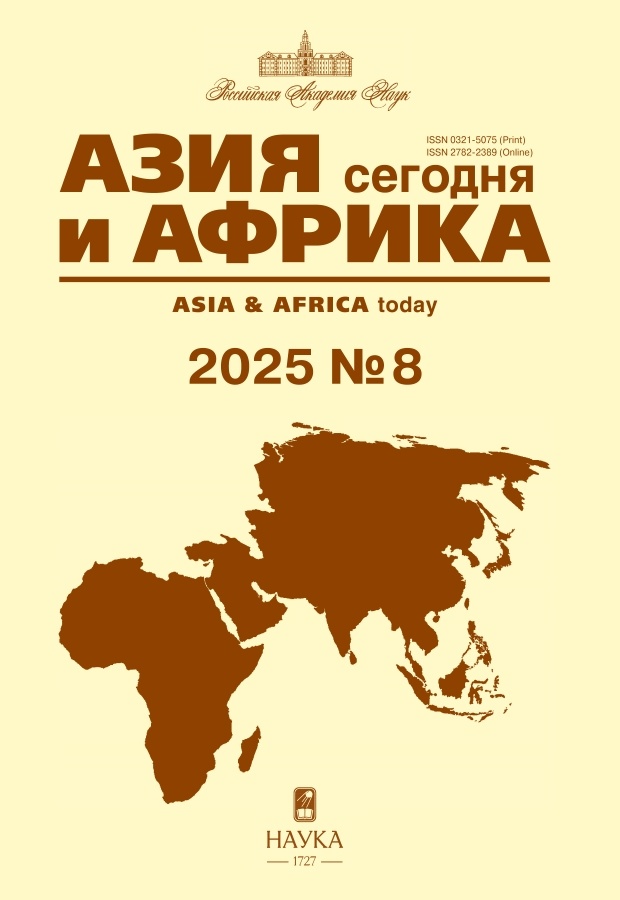Противостояние Израиля и Ирана сквозь призму китайско-израильских и индийско-израильских отношений
- Авторы: Микаелян А.А.1
-
Учреждения:
- МГИМО-Университет МИД России
- Выпуск: № 1 (2023)
- Страницы: 34-41
- Раздел: Политика, экономика
- URL: https://jdigitaldiagnostics.com/0321-5075/article/view/647265
- DOI: https://doi.org/10.31857/S032150750016679-8
- ID: 647265
Цитировать
Полный текст
Аннотация
В статье рассматривается влияние израильско-иранского противостояния на развитие отношений Тель-Авива с КНР и Индией. Акцент на эти две азиатские крупные державы не случаен – китайско-иранские отношения Пекин и Тегеран характеризуют как стратегическое сотрудничество, в то время как Нью-Дели поддерживает высокий уровень отношений с Исламской Республикой. С момента установления дипломатических отношений с КНР и Индией Израиль всячески затрагивал вопрос Ирана на переговорах с руководством Китая и Индии. С КНР акцент стоял на поставках ракетных вооружений и поддержке в 90-е гг. иранской ядерной программы. С Индией в Израиле в начале 2000-х гг. была обеспокоенность насчет возможной утечки израильских военных технологий из Индии в Иран. Поэтому Израиль предпринимал попытки оказать влияние на изменение курса политики КНР и Индии по отношению к Ирану.
Автор приходит к выводу, что усилия Тель-Авива не оказались результативными. КНР за последние годы углубила уровень своего взаимодействия с Ираном, подписав в 2021 г. соглашение о стратегическом сотрудничестве. Индия также не пересмотрела отношения с Ираном из-за усилий Израиля. В то же время торгово-экономическое сотрудничество КНР и Ирана снизилось из-за улучшения отношений Китая с монархиями Персидского залива, аналогичный процесс наблюдается и в ирано-индийских отношениях – импорт нефти из Ирана резко снизился в свете антииранской политики администрации Д.Трампа.
Ключевые слова
Полный текст
Об авторах
Арман Артакович Микаелян
МГИМО-Университет МИД России
Автор, ответственный за переписку.
Email: asaf-today@mail.ru
ORCID iD: 0000-0002-9922-245X
Кандидат исторических наук, кафедра языков стран Ближнего и Среднего Востока, МГИМО-университет МИД России
Россия, МоскваСписок литературы
- Морозов В.М. Признаки государственности ХАМАС, «Хезболлы» и ИГИЛ: Историографический обзор. Научный диалог. 2019. № 9, с. 391–406. doi: 10.24224/2227-1295-2019-9-391-406
- שגב ה. רימר א. לא שיטפון, אך זרם מתגבר – מכירת נשק מסין למזרח התיכון: מאפיינים, מגמות והשלכות על ישראל. יחסי ישראל-סין: הזדמנויות ואתגרים. מזכר 185, המכון למחקרי ביטחון לאומי, תל אביב ע ' 71-90 Segev H. Riemer O. Not a Flood, but a Rising Current: Chinese Weapons Sales to the Middle East. China-Israel Relations: Opportunities and Challenges. Memorandum 185. 2019. Pp. 71–90. (In Hebr.). https://www.inss.org.il/he/wp-content/uploads/sites/2/2018/12/%D7%9C%D7%90-%D7%A9%D7%99%D7%98%D7%A4%D7%95%D7%9F-%D7%90%D7%9A-%D7%96%D7%A8%D7%9D-%D7%9E%D7%AA%D7%92%D7%91%D7%A8-%D7%9E%D7%9B%D7%99%D7%A8%D7%AA-%D7%A0%D7%A9%D7%A7-%D7%9E%D7%A1%D7%99%D7%9F-%D7%9C.pdf (accessed 19.07.22)
- צימט ר. רימר א. כנר יש. אבידן ט. יחסי סין־איראן בעקבות הסכם הגרעין והסרת הסנקציות — שותפות בעירבון מוגבל .עדכן אסטרטגי, כרך 20, גיליון 2, יולי 2017, המכון למחקרי ביטחון לאומי, תל אביב – ע ' 37-47 Zimmit R.Р. Riemer A. Kaner I. Avidan T. China-Iran Relations following the Nuclear Agreement and the Lifted Sanctions: Partnership Inc. Strategic Assessment. 2017. Vol. 20, № 2, pp. 37–47. (In Hebr.). https://www.inss.org.il/he/wp-content/uploads/sites/2/2017/07/Adkan20-2HEB_4-1.pdf (accessed 21.07.22)
- Vatanka A. China’s Great Game in Iran. Foreign Policy. 05.09.2019. https://foreignpolicy.com/2019/09/05/chinas-great-game-in-iran/ (accessed 19.07.22)
- לים ק. היחסים בין סין לאיראן: היבטים אסטרטגיים, כלכליים ודיפלומטיים בראייה השוואתית. מזכר 215, המכון למחקרי ביטחון לאומי, תל אביב ע ' 62. 2021. Lim K. China-Iran Relations: Strategic, Economic and Diplomatic Aspects in Comparative Perspective. Memorandum 215. P. 62. 2021. (In Hebr.). https://www.inss.org.il/he/publication/iran-china-memorandum/ (accessed 19.07.22)
- Abadi J. Israel’s Quest for Recognition and Acceptance in Asia: Garrison State Diplomacy. L.: Frank Cass, 2004. P. 607.
- Yee H. Storey I. (eds) The China Threat: Perceptions, Myths and Reality. L.: Routledge. 2002. P. 344
- Shai A. Sino-Israeli Relations: Current Reality and Future Prospects. Journal of Middle Eastern and Islamic Studies (in Asia). 2011. Vol. 5. № 2, pp. 17–42. doi: 10.1080/19370679.2011.12023178
- אוריון א. יחסי ישראל-סין – שותפות אסטרגית בע"מ: עיקרי מסקנות והמלצות לישראל. מזכר, המכון למחקרי ביטחון לאומי, תל אביב המכון Orion A. Strategic Partnership Ltd.: China-Iran Relations and their Significance for Israel. The Institute for National Security Studies. Tel-Aviv. 2021. (In Hebr.). https://www.inss.org.il/he/wp-content/uploads/sites/2/2021/03/ %D7%A4% D7%A8%D7%A1%D7%95%D7%9D-%D7%9E%D7%99%D7%95%D7%97%D7%93-290321.pdf (accessed 21.07.22)
- פלדמן ב.ח. לביא ג. סין, רוסיה ושיחות הגרעין בווינה: המתנה שלא מפסיקה לתת. מבט על, גיליון 1557, 2022 Feldman-Druyan B.C. Lavi G. China, Russia, and the Nuclear Talks in Vienna: The Gift that Keeps Giving. INSS Insight № 1557, 2022. https://www.inss.org.il/he/publication/china-russia-jcpoa/ (accessed 19.07.22)
- Shichor Y. Israel and China: Mutual demystification in Chinese-Israeli relations. Israel and The World Powers: Diplomatic Alliances and International Relations beyond the Middle East. 2014. I.B.Tauris & CO Ltd, Pp. 106–124. doi: 10.5040/9780755611522.ch-005
- Микаелян А.А., Морозов В.М. Фактор США в израильско-китайских и израильско-индийских отношениях. Вестник РУДН. Серия: Международные отношения. 2021. Vl. 21, № 2, с. 338–349. doi: 10.22363/2313-0660-2021-21-2-338-349
- Sen A. India-Iran trade dips 79.4 per cent in April-Nov: may fall further. The Hindu. 07.01.2020. https://www.thehindubusinessline.com/economy/india-iran-trade-dips-794-per-cent-in-april-nov-may-fall-further/ article30505810.ece (accessed 21.07.22)
- Teja J. India-Iran Relations in a New Context. American Foreign Policy Interests. 2015. Vol. 37. Pp. 87–94. doi: 10.1080/10803920.2015.1038922
- Baidya S. India’s Policy towards Iran: Reflection of Intentions, Ambiguities and Complexities. International Studies. 2017. Vol. 54. № 1-4. Pp. 141–161. doi: 10.1177/0020881718790432
- Cheema S. A. Essays on Iran and Israel: An Indian Perspective. KW Publishers Pvt Ltd. 2014. P. 230.
- שפיר י. על חבל דק – ישראל, הודו ואיראן \ י. שפיר \\ עדכן אסטרטגי המכון למחקרי ביטחון לאומי, תל אביב , כרך 16, גיליון 1, אפריל 2013 ע ' 65 - 74 Shapir Y. Walking a Fine Line: Israel, India and Iran. Strategic Assessment. 2013, V. 16, № 1, pp. 65–74. (In Hebr.). https://www.inss.org.il/he/wp-content/uploads/sites/2/systemfiles/%D7%A9%D7%A4%D7%99%D7%A8.pdf (accessed 21.07.22)
- Basu M. Oil, Chabahar, ‘violence against Muslims’ – why India-Iran ties are going into free fall. The Print. 2020. https://theprint.in/diplomacy/oil-chabahar-violence-against-muslims-why-india-iran-ties-are-going-into-free-fall/376836/ (accessed 21.07.22)
- Agarwal R. India-Iran Ties are Ripe for a Reset. The Diplomat. 2022. https://thediplomat.com/2022/06/india-iran-ties-are-ripe-for-a-reset/ (accessed 21.07.22)
- Лиокумович Я.Б., Ахматшина Э.К. (Санкт-Петербург). «Авраамовы соглашения» между Израилем, ОАЭ и Бахрейном: изменения геополитической реальности Ближнего Востока. Азия и Африка сегодня. 2022. № 2. С. 64–68. doi: 10.31857/S032150750016335-0
Дополнительные файлы










